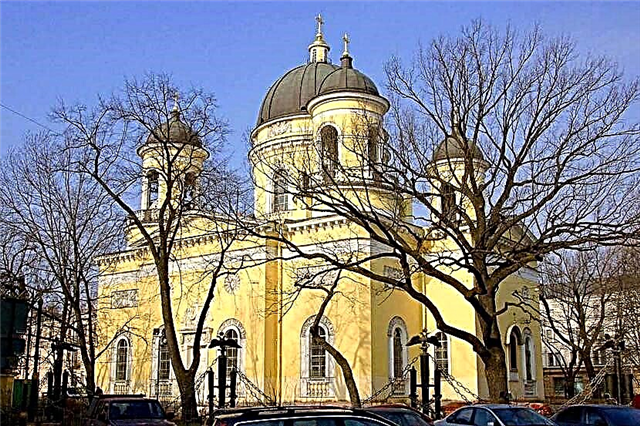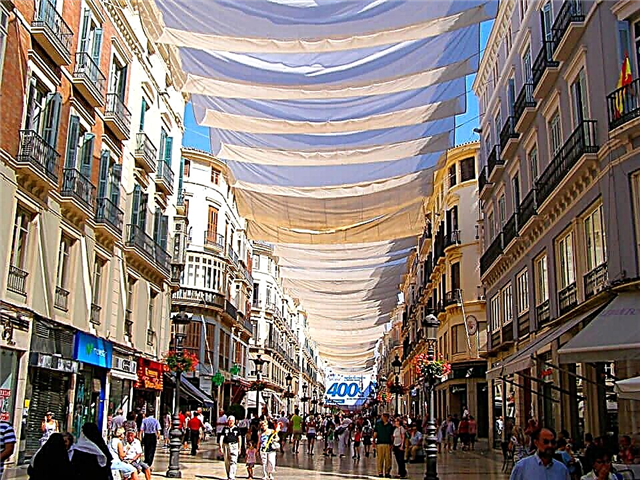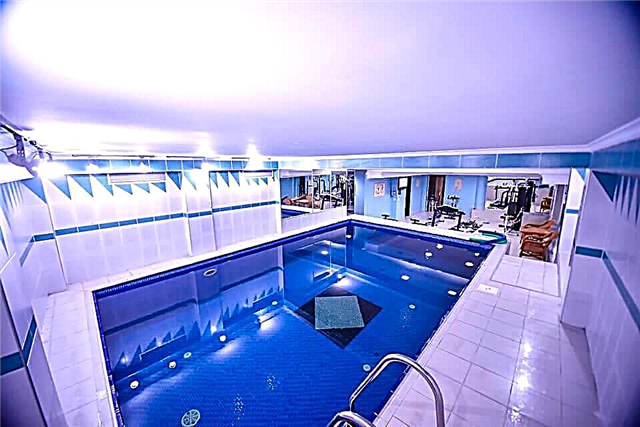Address: Russia, Saint Petersburg, Preobrazhenskaya square
Building: 1825 - 1829
Architect: Vasily Petrovich Stasov
Coordinates: 59 ° 56'35.0 "N 30 ° 21'09.4" E
Object of cultural heritage of the peoples of the Russian Federation
Content:
On the beautiful Preobrazhenskaya Square there is a majestic five-domed cathedral - the regimental temple of the Preobrazhensky regiment, which is often called the "guards" one. This is one of the few churches in St. Petersburg that have never been closed for church services. The graceful stucco panels on the facades, a fence made of cast-iron tools and paintings remind of military paraphernalia. A visit here is a real journey into the history of Russia!

Spaso-Preobrazhensky Cathedral from a bird's eye view
Construction history
In 1741, the grenadiers of the Preobrazhensky Life Guards Regiment helped the daughter of Peter I, Elizaveta Petrovna, to make a palace coup and ascend the Russian throne. The new empress was grateful to the faithful soldiers and officers, and therefore ordered the architect Mikhail Zemtsov to design the regimental church.
They decided to place the church where the regiment's headquarters used to be, as they said at that time, "leaving the hut." It is curious that it was in this place that the future empress prayed for the return of the throne, which was illegally taken from her by Anna Leopoldovna.
In 1743, after the death of Zemtsov, the construction was headed by the architect Pietro Antonio Trezzini. He changed the original design. In August 1754, shortly before the feast of the Transfiguration, in the presence of the Empress, Archbishop Sylvester consecrated the new cathedral.

View of the Transfiguration Cathedral from Pestel Street
A baroque five-domed church with a graceful five-tiered iconostasis and a carved altar canopy appeared in St. Petersburg. It became one of the first stone churches of the city under construction. In 1796, during the reign of Emperor Paul I, the temple was awarded the honorary title of “the cathedral of all the guards”.
In 1825, a terrible disaster struck. A fire started in the church building. While the flames were burning, the ministers and parishioners managed to take out valuable icons and liturgical utensils. The cathedral itself could not be saved. From the majestic building, only one burnt walls remained.
The chagrined Emperor Nicholas I ordered the restoration of the cathedral to the architect Vasily Stasov. Since little has survived from the old temple, the architect prepared an original project in the Empire style popular at that time. The construction took 4 years. In 1829, the new church was consecrated by Metropolitan Seraphim.

General view of the Transfiguration Cathedral and Preobrazhenskaya Square
The history of the temple in the 19th and 20th centuries
In the 19th century, the "guards" church was very popular in the city. Contemporaries said that St. Petersburg is famous for two churches - the Kazan Cathedral and the Transfiguration Cathedral.
Since the 1870s, a charitable society has been organized here. The money raised was used to support an almshouse for the elderly and sick, an orphanage and a canteen. There was a school for soldiers' children at the temple, and there were free apartments. Every year in August, a large fruit market was held on the square near the building.
After the revolution, the cathedral received the status of a parish church. All military relics of the Preobrazhensky regiment were transferred to the Artillery Museum. In the years when the confiscation of valuables in favor of the starving in the Volga region took place in the country, many ancient icons disappeared from the cathedral without a trace.

During the Leningrad blockade, a bomb shelter was made in the basement of the church. During artillery shelling and bombing, up to 500 people were hiding in it. Doctors and nurses also worked here to help the wounded. During the most difficult years, the services did not stop.
When the war ended, parishioners and city officials found funds to restore the facades and interiors of the cathedral. In 1950, the military banners, standards, weapons, trophies of the guardsmen and the uniforms of the Transfiguration of several Russian sovereigns ended up in the vaults of the Hermitage.
Architectural features
There are many architectural monuments among the cathedrals and churches of St. Petersburg. The Transfiguration Cathedral is no exception. The majestic temple is a vivid example of the traditions of the Russian Empire style. It rises 41.5 m, which corresponds to the height of a 14-storey building. The cathedral stands next to Liteiny Avenue, where the Preobrazhensky barracks used to be.

The facades of the main volume are decorated with strict four-column porticos of the Ionic order. The massive main dome is crowned with a large illuminated drum, and four bell towers rise around it. A round tower clock can be seen on the northwestern dome.
Interior decoration
In an Orthodox church, three limits are consecrated. The main one is dedicated to the feast of the Transfiguration, revered by believers, the southern one - to Sergius of Radonezh, and the northern one - to the holy martyrs Archbishop Peter of Alexandria and Pope Clement I.
The vault of the main dome is painted under the sky with clouds. A large star flaunts in its center. The cathedral is lit with natural light from semicircular windows. In addition, a huge chandelier hangs under the dome, which is designed for 120 candles.

View of the domes of the Transfiguration Cathedral
The iconostasis of the main chapel is divided into four tiers. It was made according to the sketches of Vasily Stasov. The icons were painted by famous painters Alexei Egorov, Grigory Ugryumov, Vasily Shebuev and Andrei Ivanov, who lived at the turn of the 18th-19th centuries. The painting of the interiors of the cathedral was made according to Shebuev's drawings.
The amazing quality of the carving of the pulpit, which was made by the skilled craftsman from Kostroma Vasily Zakharov, is striking. An old fold is kept in the cathedral. In 1900, this folding altar was presented to the temple by a member of the imperial family - Grand Duke Konstantin Konstantinovich.
The oldest icon of the cathedral is remarkable - the image of the Savior Not Made by Hands of the 17th century. It was written by the famous Moscow iconographer Simon Ushakov for Tsar Alexei Mikhailovich. Peter I loved this image very much and took it with him everywhere.
Commemorative fence
In 1828-1829, Russia and the Ottoman Empire fought with each other. After the war, the Peace of Adrianople was concluded. Russia received most of the eastern coast of the Black Sea and the Danube delta. 10 thousand Russian soldiers were killed in bloody battles. Another 5,000 died of wounds, and 110,000 died of illness during the marches.

The main entrance to the Transfiguration Cathedral
In memory of this war, an unusual fence was built around the cathedral from captured cannons obtained in the battles for the fortresses of Izmail, Tulcha, Varna, Silistria and Isakchi. By decree of the Russian Tsar Nicholas I, the Guards Cathedral was presented with 18-pound and 24-pound guns.
On the cast-iron barrels one can see the Ottoman coat of arms and the names given to the guns by the Ottomans: "The Sacred Crescent", "The Wrath of Allah", "I give only death and" Emitting thunder ". The fact that the tools were made named is not surprising. In Russia, the names of the guns were also cast. The famous cannon master Andrey Chokhov made the "Wolf", "Skoropieya" and "Lion" squeaks.
The temple fence has 34 granite bases, each of which has three cannons. The guns are placed with muzzles to the ground. This means that they will never again participate in the war.
At the main gate, you can see enlarged copies of the commemorative medal. On one side there is a laurel wreath and the inscription "For the Turkish War", and on the other there is a cross over the defeated crescent and the years "1828-1829" are indicated. The same gilded cross adorns the gate above.

The main gate with copies of commemorative medals on the leaves
Medium cannons on pedestals are crowned with gilded coats of arms of Russia - double-headed eagles. Massive cast-iron chains are stretched between the granite foundations and the tools. After the revolution, the cross on the central gate and the eagles were removed, but in 2004 the memorial fence was returned to its original appearance.
Useful information for pilgrims and tourists
The old cathedral has been beautifully restored. Its facades and bells have been renovated in recent years. In the evenings, the building is beautifully illuminated, and on holidays, bright illumination is arranged in the park around. Tourists and believers note that the interior of the temple is homelike.
There is a Sunday school at the cathedral, where children 5-15 years old and adults study. There is a youth club and a circle for the study of the Scriptures. Temple social services help the homeless and needy.

Cathedral interiors
The doors of the cathedral are open to everyone from morning to evening. Church services are held every day at 10:00 and 18:00. On Wednesdays, Fridays and Sundays, there is an additional early liturgy - at 7:00. Many come here specially to listen to the harmonious singing of the church choir.
How to get there
The cathedral stands in the historic center of the city, on the left bank of the Neva. Half a kilometer away is the Chernyshevskaya metro station.











